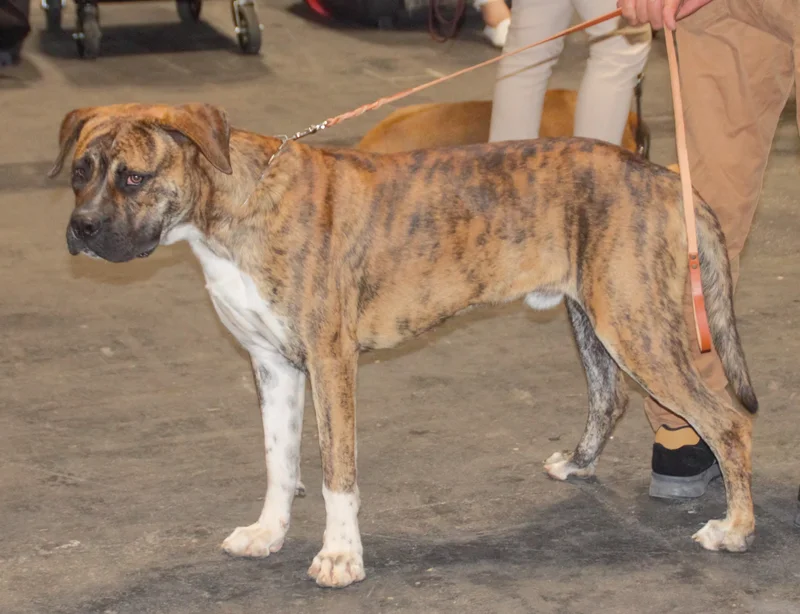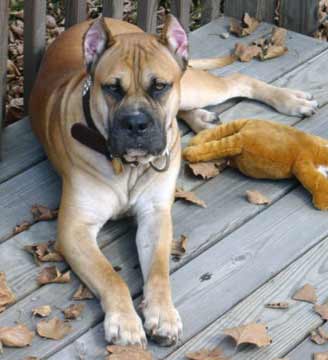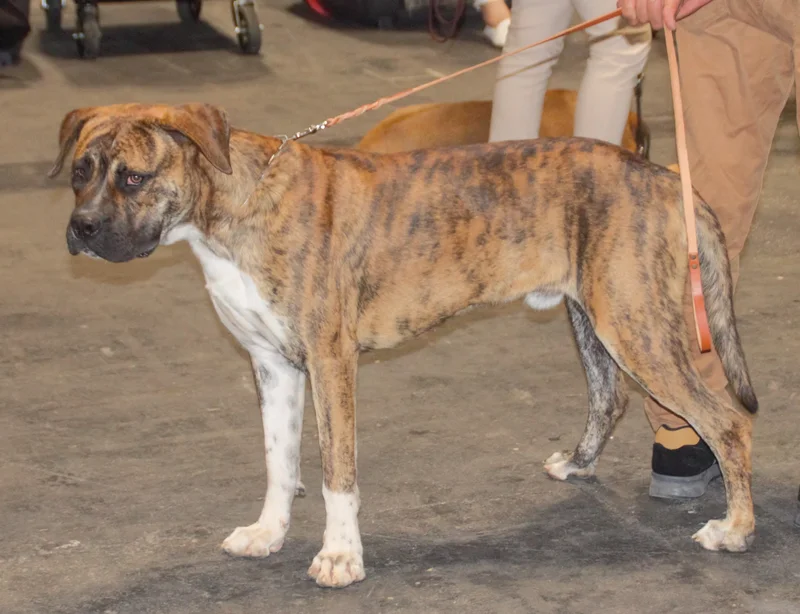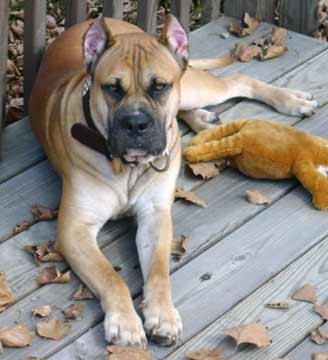Alano Español
The Alano Español, or Spanish Bulldog, is a large, powerful breed known for its strength and sociable nature. With a rich history in hunting and bullfighting, this loyal companion thrives in active households.
Overview
🐕Breed Overview
The Alano Español, often referred to as the Spanish Bulldog, is a majestic breed with a rich history rooted in Spain. Known for its impressive size and strength, this Molosser-type dog has been utilized for various purposes, including hunting and bullfighting. With a robust build, the Alano typically stands between 23 to 26 inches at the shoulder and weighs between 75 to 88 pounds.
Its short, thick coat comes in a variety of colors, predominantly brindle, fawn, or black, often accented with white markings. The breed's powerful head and muscular body reflect its heritage as a working dog, while its sociable nature makes it a loyal companion. Historically, the Alano Español was bred by the Alani tribe, who migrated to Spain in the 5th century.
These dogs were essential for herding livestock and hunting large game, showcasing their versatility and strength. The breed's presence in Spanish culture is notable, particularly in bullfighting, where they were used to bait bulls, a practice depicted in the art of Francisco de Goya. Despite facing extinction in the 20th century, dedicated breeders revived the Alano Español, leading to its recognition as an indigenous Spanish breed in 2004.
The Alano Español is known for its friendly and sociable temperament, especially with other dogs. However, early socialization and training are crucial to ensure they develop into well-rounded companions. Regular exercise is essential for this breed, as they require at least 60 to 90 minutes of vigorous activity daily to maintain their health and happiness.
Owners should engage their Alano in activities that challenge both their physical and mental abilities, such as agility training or herding exercises. In terms of grooming, the Alano Español has low maintenance needs due to its short coat, requiring only occasional brushing to remove loose hair. Health-wise, the breed is generally robust, with no specific health issues documented, making them a resilient choice for active families.
Overall, the Alano Español is an impressive breed that combines strength, loyalty, and a rich cultural heritage. They thrive in active households where they can participate in various activities and receive the training and socialization they need to flourish as beloved family members.
Breed Characteristics
Family & Friends
Good Behavior
Get Up & Go
Household Harmony
Temperament & Personality
✨Key Traits
🐕Core Temperament
The Alano Español has a balanced temperament, characterized by loyalty, intelligence, and a protective nature. They are friendly and sociable with other dogs, making them suitable for multi-pet households.
Early socialization is essential to ensure they develop into well-adjusted companions. This breed is known for its strong work ethic and enjoys having tasks to complete, whether it's participating in dog sports or engaging in training exercises.
While they can be independent, they thrive on human interaction and companionship, making them excellent family pets.
💫Personality Profile
The Alano Español is known for its loyalty and protective nature, making it an excellent family companion. They are sociable with other dogs and generally friendly with humans, although early socialization is crucial.
This breed is intelligent and eager to learn, which makes training relatively straightforward. However, they can be strong-willed, so consistent training and clear boundaries are essential.
Alanos are active dogs that enjoy engaging in physical activities and require regular exercise to keep them happy and healthy. Their playful nature and affectionate demeanor make them great companions for families, but they do best in homes where they receive ample attention and interaction.
🔊Vocal Tendencies
The Alano Español is generally not a vocal breed, with a barking tendency rated at 2 out of 5. They may bark to alert their owners of strangers or unusual occurrences, but excessive barking is not typical.
Their vocalizations are usually reserved for specific situations, such as play or when they are excited. Overall, they are relatively quiet dogs, making them suitable for various living environments.
Affection & Social Traits
Energy & Activity
Communication Style
Care Requirements
🏃♂️Exercise Requirements
Daily Exercise
The Alano Español is a large, powerful breed that requires a significant amount of exercise to maintain its physical and mental health. Ideally, an adult Alano should engage in at least 60 to 90 minutes of vigorous exercise daily.
This can include activities such as long walks, running, playing fetch, or participating in dog sports like agility or obedience training. Puppies and younger dogs may require shorter, more frequent sessions to accommodate their developing bodies, while senior dogs may benefit from gentler activities like swimming or leisurely walks.
Regular exercise is crucial for preventing obesity, managing energy levels, and reducing the likelihood of behavioral issues such as destructiveness or anxiety. Insufficient exercise can lead to weight gain, boredom, and potential aggression, making it essential for owners to prioritize their Alano's physical activity.
🏠Living & Adaptability
Space Requirements
The Alano Español thrives in a spacious environment, ideally a home with a large yard where it can roam and play freely. While they can adapt to apartment living, it is crucial that they receive ample exercise and mental stimulation outside.
Owners in smaller living spaces should ensure they can provide daily walks and playtime in parks or open areas. Given their size and energy levels, confinement in small spaces without adequate exercise can lead to frustration and destructive behaviors.
Therefore, a rural or suburban setting with access to outdoor activities is highly recommended for this breed.
Climate Preference
🍲Feeding Guide
Schedule
Food Types
Portion Size
Special Nutritional Needs
The Alano Español requires a balanced diet rich in protein to support its muscular build and active lifestyle. Owners should choose high-quality dog food formulated for large breeds, ensuring it meets the specific nutritional needs of their dog. Regular veterinary check-ups can help monitor the dog's weight and adjust dietary needs accordingly.
✨Grooming Requirements
Grooming Overview
The Alano Español has a short, thick coat that requires minimal grooming. Regular brushing, approximately once a week, is sufficient to remove loose hair and keep the coat healthy.
Bathing should be done as needed, typically every few months or when the dog becomes particularly dirty. Owners should also pay attention to the dog's ears, ensuring they are clean and free from debris, and check the nails regularly, trimming them as necessary to prevent overgrowth.
Overall, grooming this breed is straightforward and does not require specialized tools or techniques.
Care Schedule
Brush weekly; bathe as needed (every 2-3 months); trim nails monthly.
Health Profile
⚕️Health Care
Regular health care is vital for the longevity of the Alano Español. Routine veterinary check-ups, vaccinations, and preventive treatments can help detect health issues early and maintain optimal health throughout the dog's life.
Owners should also be vigilant about dental care, as dental disease can affect overall health. Establishing a consistent health care routine will contribute to a longer, healthier life for the Alano.
⏳Average Lifespan
Genetic Factors
Genetics play a significant role in the lifespan of the Alano Español. Responsible breeding practices that prioritize health and genetic diversity can help reduce the risk of hereditary health issues.
Potential owners should seek breeders who conduct health testing and provide transparency regarding the lineage of their dogs. Understanding the genetic background can help owners anticipate potential health challenges and take proactive measures to ensure their dog's well-being.
Living Conditions
The Alano Español thrives in environments that allow for ample physical activity and social interaction. Access to outdoor spaces is crucial for their exercise needs, and living in a climate that is not too extreme will support their overall health.
Regular interaction with humans and other dogs can enhance their social skills and reduce anxiety, contributing to a longer lifespan. Owners should ensure that their living conditions are conducive to the breed's active lifestyle, providing opportunities for exercise and mental stimulation.
Training
🧠Intelligence & Trainability
💪Work Drive
The Alano Español has a strong work drive, stemming from its historical roles as a hunting and working dog. This breed thrives when given tasks to complete, whether it's participating in dog sports, engaging in obedience training, or helping with herding activities.
Mental stimulation is just as important as physical exercise for this breed. Owners should provide opportunities for problem-solving and interactive play to keep their Alano mentally engaged.
Without sufficient mental and physical challenges, the breed may become bored and exhibit undesirable behaviors.
⚠️Training Considerations
The Alano Español is generally sociable with other dogs, but its size and strength can pose challenges if not properly socialized from a young age. Common behavioral challenges include dominance issues and territoriality, particularly if the dog is not adequately trained or socialized.
To overcome these challenges, early socialization with various people, dogs, and environments is crucial. Consistent training using positive reinforcement methods can help establish boundaries and encourage good behavior.
Owners should also be aware of the breed's strong prey drive, which may lead to chasing smaller animals. Training should include recall commands and impulse control exercises to manage this instinct effectively.
📝Training Tips
Training an Alano Español requires patience and consistency. Positive reinforcement methods, such as treats and praise, work best with this breed.
Start training early, focusing on basic commands and socialization. Incorporate mental stimulation through puzzle toys and interactive games to keep them engaged.
Regular training sessions should be maintained throughout the dog's life to reinforce good behavior and prevent boredom. Given their intelligence and eagerness to please, Alanos can excel in obedience training and dog sports if provided with the right motivation and guidance.
History & Heritage
📜Origin Story
The Alano Español's origin is intertwined with the migration of the Alani tribe to Spain during the 5th century. These nomadic pastoralists brought large dogs that were essential for herding and guarding livestock.
Over time, these dogs evolved into various regional Alaunt types, including the Alano Español. The breed gained prominence in Spain, particularly in the context of bullfighting, where it was used to bait bulls.
The breed's historical significance is further emphasized by its depiction in art and literature, showcasing its role in Spanish culture. Despite facing near extinction in the 20th century, the Alano Español has been revitalized through dedicated breeding efforts, ensuring its survival and recognition as an indigenous Spanish breed.
⏳Development History
The Alano Español's development can be traced back to the 5th century when the Alani tribe migrated to Spain. They brought with them large dogs used for guarding livestock and hunting.
' Over the centuries, the Alano was utilized in various roles, including as war dogs and in bullfighting. However, by the 1960s, the breed faced extinction due to changing societal needs and the decline of bullfighting.
In the 1970s, dedicated breeders rediscovered the breed in northern Spain, leading to its formal recognition by the Spanish Kennel Club in 2004. This recognition marked a significant step in preserving the breed's unique characteristics and heritage.
🛡️Purpose & Historical Role
Historically, the Alano Español was bred for various purposes, including hunting large game like wild boar and serving as a bullfighting dog. Its strength and tenacity made it an ideal candidate for these roles.
The breed was also used as a war dog during the Spanish conquests in the Americas, showcasing its versatility and importance in different contexts. Today, while its traditional roles have diminished, the Alano is still valued for its hunting abilities and as a loyal companion.
🏺Cultural Significance
The Alano Español has deep historical roots in Spain, where it was originally bred for various purposes, including hunting and bullfighting. Its lineage traces back to the Iranian Alani tribe, known for their large livestock guardian dogs.
The breed played a significant role in Spanish culture, particularly in bullfighting, where it was used to bait bulls. The Alano's presence in art, such as Francisco de Goya's depictions of bullfighting, highlights its cultural importance.
Despite its decline in numbers due to changes in agricultural practices and the outlawing of bullfighting, the breed has seen a resurgence thanks to dedicated fanciers who recognized its historical value and unique characteristics.
Conservation Status
This breed is less common but has stable populations in certain regions.





